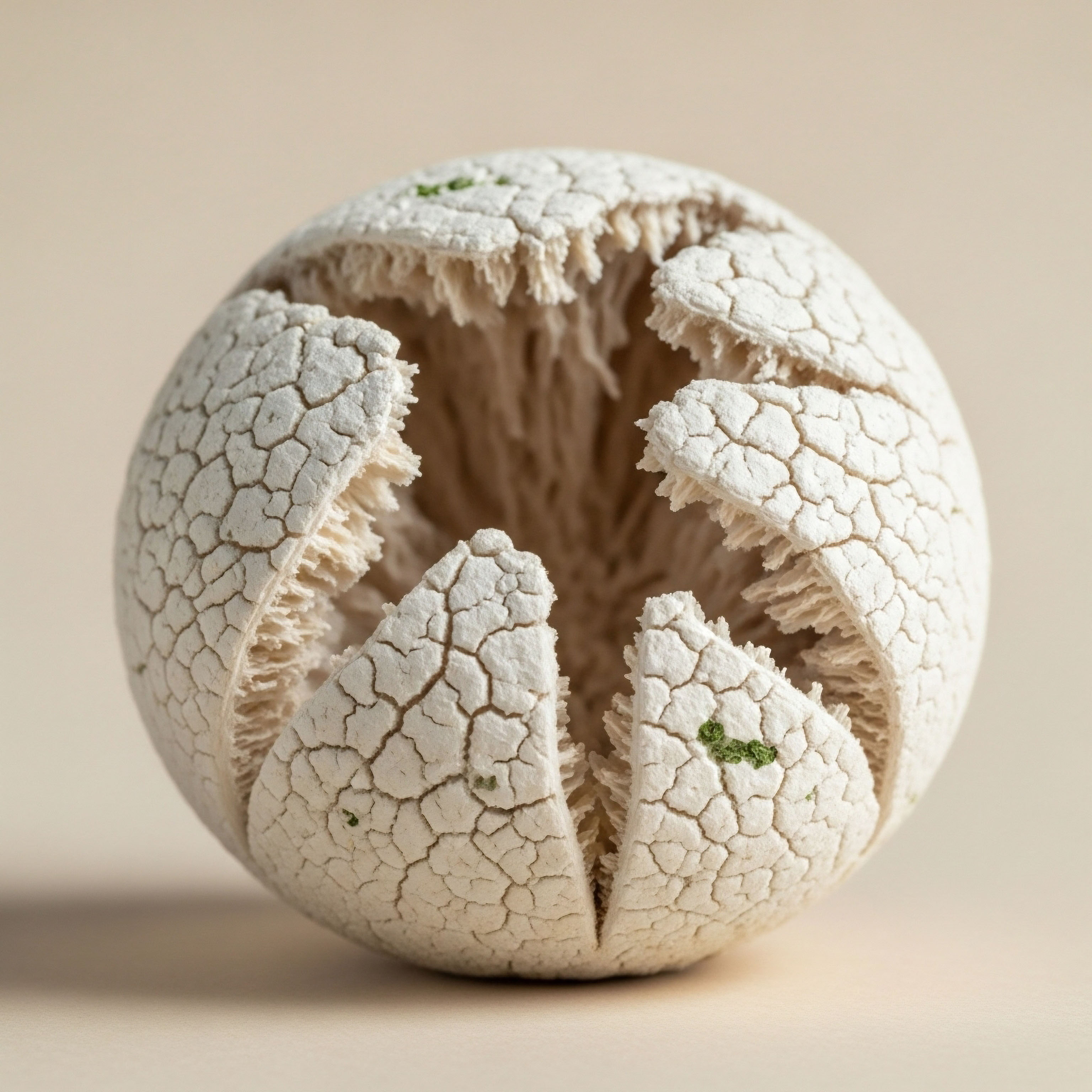

Fundamentals
You may feel a persistent sense of imbalance, a collection of symptoms that medical appointments have struggled to connect. Fatigue, mood fluctuations, stubborn weight gain, or changes in your cycle are often treated as isolated issues. Your lived experience, however, suggests a deeper, systemic cause.
This feeling of being unheard or misunderstood is a common starting point for many on a journey to reclaim their vitality. The disconnect you sense is real, and its roots often lie within the intricate communication network of your endocrine system, specifically in the way your body manages estrogen. Understanding this system is the first step toward addressing the core of these concerns.
The conversation about hormonal health frequently revolves around the ovaries or adrenal glands, yet a significant part of the story unfolds within your digestive tract. Your gut is home to a complex ecosystem of trillions of microorganisms, collectively known as the gut microbiome.
Within this ecosystem resides a specialized group of bacteria with a unique and powerful function ∞ the ability to metabolize and regulate estrogen. This collection of microbes is called the estrobolome. Its health and diversity directly influence how much estrogen is circulating in your body, impacting everything from your menstrual cycle and mood to your metabolic rate and long-term health.
The symptoms you are experiencing are not just in your head; they are biochemical signals of a system that requires recalibration, and the gut is a primary control center for that process.

The Estrobolome Your Body’s Estrogen Regulator
Your liver processes estrogens, preparing them for removal from the body. It attaches a molecule to each estrogen, effectively tagging it for excretion through the bile into the intestines. Here, in the gut, the estrobolome comes into play. Certain gut bacteria produce an enzyme called beta-glucuronidase.
This enzyme can cut off the tag the liver attached, allowing the estrogen to be reabsorbed back into circulation. A balanced microbiome produces just the right amount of this enzyme, maintaining estrogen at healthy levels. An imbalanced microbiome, a state known as dysbiosis, can disrupt this delicate process.
Too much beta-glucuronidase activity leads to excess estrogen reabsorption, contributing to conditions of estrogen dominance. Too little activity can result in low estrogen levels. This biological mechanism validates your experience of feeling “off,” as it demonstrates a direct link between your gut health and the hormonal symptoms you feel daily.
Your gut’s microbial community plays a direct role in regulating the amount of active estrogen circulating throughout your body.

Diet the Primary Architect of Your Gut Health
The composition of your estrobolome is profoundly shaped by your dietary choices. The food you consume provides the raw materials that either support a diverse, beneficial microbial community or promote the overgrowth of less helpful bacteria. This gives you a direct and powerful tool to influence your hormonal health.
Making intentional, targeted dietary changes is a foundational strategy for recalibrating your body’s internal hormonal environment. These are not merely lifestyle adjustments; they are precise interventions designed to modulate your biology from the inside out.
A diet rich in fiber from a wide variety of plant sources is fundamental. Fiber is indigestible by human enzymes, so it travels to the colon where it becomes the primary food source for your beneficial gut bacteria.
These microbes ferment fiber, producing short-chain fatty acids (SCFAs) like butyrate, which nourish the cells lining your colon and support a healthy gut barrier. A strong gut lining prevents inflammatory molecules from leaking into the bloodstream, which could otherwise disrupt liver function and impair estrogen detoxification. Furthermore, fiber binds to excreted estrogens in the gut, ensuring their removal through regular bowel movements and preventing their reabsorption.
Cruciferous vegetables, such as broccoli, cauliflower, and Brussels sprouts, contain a compound called indole-3-carbinol. This compound supports the liver’s detoxification pathways, promoting the conversion of potent estrogens into weaker, less stimulating forms. Similarly, probiotic-rich fermented foods like yogurt, kefir, and sauerkraut introduce beneficial bacteria directly into your gut, helping to restore a healthy balance. By focusing on these foods, you are actively cultivating a microbial ecosystem that supports hormonal equilibrium.


Intermediate
For those already familiar with the foundational link between gut health and hormonal balance, the next step is to understand the specific, actionable protocols that leverage this connection. When diet and lifestyle modifications are insufficient to resolve persistent symptoms of hormonal imbalance, targeted interventions become necessary.
This is where hormonal optimization protocols, such as hormone replacement therapy (HRT), intersect with gut health. The effectiveness of these clinical strategies is not determined solely by the dose of the hormone administered; it is significantly influenced by the metabolic environment of your gut. A dysfunctional estrobolome can undermine even the most precise hormonal interventions, while a healthy one can amplify their benefits.
The gut microbiome acts as a dynamic filter and regulator for both endogenous (produced by your body) and exogenous (introduced through therapy) hormones. Dysbiosis can lead to the inefficient metabolism of therapeutic hormones, altering their intended effects and potentially increasing the risk of side effects.
For instance, if your gut microbiome is producing excessive beta-glucuronidase, it can reactivate prescribed estrogens at a higher rate than anticipated, leading to symptoms of estrogen excess like bloating, mood swings, or breast tenderness, even on a standard dose of HRT.
Conversely, a microbiome that is depleted of these key bacteria may fail to properly activate hormones, rendering the therapy less effective. Therefore, a comprehensive approach to hormonal wellness involves preparing the gut to work in concert with any prescribed hormonal protocol.

Optimizing the Gut for Hormonal Interventions
Before and during any hormonal therapy, a strategic focus on gut health is a clinical priority. The goal is to create a resilient and balanced microbiome that can properly metabolize hormones and support the body’s detoxification systems. This involves a multi-pronged approach that goes beyond a generic “healthy diet” and incorporates specific, evidence-based nutritional strategies and, when necessary, targeted supplementation. This process ensures that the body is primed to receive and utilize hormonal support effectively and safely.

How Can You Prepare Your Gut for Hormonal Therapy?
Preparing the gut involves a systematic process of removing inflammatory triggers, restoring beneficial bacteria, and providing the necessary nutrients for optimal gut function and hormone metabolism. This is often conceptualized as a clinical framework that can be personalized based on individual symptoms, health history, and laboratory testing. The objective is to create an internal environment conducive to hormonal harmony.
- Dietary Fiber Diversity A high-fiber diet is the cornerstone of a healthy microbiome, but the diversity of that fiber is what builds a truly resilient ecosystem. Aiming for 30 or more different plant species per week provides a wide array of prebiotic fibers, each feeding different families of beneficial bacteria. This includes soluble fiber from sources like oats, apples, and beans, which forms a gel-like substance that helps bind and excrete excess hormones, and insoluble fiber from nuts, seeds, and vegetables, which adds bulk to stool and ensures regular transit time.
- Phytoestrogen Incorporation Phytoestrogens are plant-derived compounds that can bind to estrogen receptors in the body. They have a weaker effect than endogenous estrogen and can act as modulators, blocking estrogen receptors when levels are too high and providing mild stimulation when levels are too low. Foods rich in phytoestrogens, such as ground flaxseed, chickpeas, and organic, non-GMO soy (in the form of tempeh or miso), can help buffer the effects of hormonal fluctuations. Their metabolism is also dependent on a healthy gut microbiome, creating a synergistic relationship.
- Targeted Probiotic and Prebiotic Use While fermented foods are beneficial, some individuals may require more targeted support. Specific probiotic strains, such as those from the Lactobacillus and Bifidobacterium families, have been shown to support a healthy gut environment. Prebiotic supplements, like psyllium husk or acacia fiber, can provide a concentrated source of fuel for these beneficial microbes, further enhancing their growth and activity.

The Role of Lifestyle Factors
Diet is a primary driver of gut health, but other lifestyle factors also exert a powerful influence on the microbiome and its ability to regulate estrogen. Chronic stress, poor sleep, and a sedentary lifestyle can all contribute to dysbiosis and undermine hormonal balance. Therefore, a truly integrative approach must address these elements as well.
Chronic stress elevates cortisol, which can negatively impact gut barrier function, leading to a “leaky gut.” This allows inflammatory endotoxins to enter the bloodstream, placing a burden on the liver and impairing its ability to detoxify estrogens. Practices such as mindfulness, meditation, or even deep breathing exercises can help mitigate the physiological effects of stress.
Regular physical activity, particularly a combination of cardiovascular exercise and resistance training, has been shown to increase microbial diversity and improve gut transit time, further aiding in the excretion of excess hormones.
| Food Category | Primary Function | Examples |
|---|---|---|
| Cruciferous Vegetables | Support Liver Detoxification | Broccoli, Cauliflower, Kale, Brussels Sprouts |
| High-Fiber Foods | Bind and Excrete Estrogen | Legumes, Berries, Whole Grains, Nuts, Seeds |
| Probiotic-Rich Foods | Introduce Beneficial Bacteria | Yogurt, Kefir, Sauerkraut, Kimchi, Miso |
| Phytoestrogen Sources | Modulate Estrogen Receptors | Ground Flaxseed, Chickpeas, Organic Tempeh |


Academic
A sophisticated understanding of hormonal health requires moving beyond systemic effects to the molecular level, where the interplay between the gut microbiome, estrogen metabolism, and hormonal interventions is governed by precise biochemical pathways. The efficacy of hormonal therapies is contingent upon a complex series of metabolic conversions, many of which are directly mediated by the enzymatic activity of the gut microbiota.
The estrobolome, the aggregate of enteric bacterial genes capable of metabolizing estrogens, represents a critical control point in maintaining estrogen homeostasis. Its functional state can determine the clinical outcome of hormonal protocols, a factor that is gaining increasing recognition in the fields of endocrinology and personalized medicine.
The primary mechanism of interest is the enterohepatic circulation of estrogens. After conjugation in the liver, primarily through glucuronidation and sulfation, estrogens are excreted via the bile into the intestinal lumen. Here, they are subject to deconjugation by bacterial enzymes, most notably β-glucuronidase and sulfatase.
This enzymatic action liberates the biologically active estrogen, allowing it to be reabsorbed into the portal circulation and returned to systemic circulation. The level of β-glucuronidase activity in the gut is therefore a rate-limiting step that dictates the proportion of estrogen that is reabsorbed versus excreted. High β-glucuronidase activity is associated with increased circulating levels of estrogens, a biochemical state linked to a higher risk of estrogen-sensitive conditions.

The Molecular Dialogue between Microbiome and Hormones
The interaction between the gut microbiome and estrogen is bidirectional. While the microbiome modulates estrogen levels, estrogens themselves also shape the composition of the gut microbiota. Estrogen receptors (ERα and ERβ) are expressed in the intestinal epithelium, and their activation can influence gut permeability and local immune responses, thereby altering the microbial habitat.
This creates a feedback loop where hormonal status and gut health are deeply intertwined. During menopause, for example, the decline in estrogen is associated with a decrease in microbial diversity, which can in turn exacerbate the metabolic consequences of estrogen deficiency, such as weight gain and insulin resistance.
The enzymatic activity of the estrobolome directly modulates the enterohepatic circulation of estrogens, functioning as a key determinant of systemic hormonal exposure.

How Does Gut Dysbiosis Impact Specific Hormonal Therapies?
In the context of hormone replacement therapy, the state of the gut microbiome becomes a crucial variable in predicting patient response. For a woman on oral estrogen therapy, a hyperactive estrobolome can lead to supraphysiological levels of circulating estrogen, potentially increasing the risk of adverse effects.
For a man on testosterone replacement therapy (TRT), a portion of testosterone is aromatized into estradiol. An imbalanced gut microbiome can exacerbate this conversion and subsequent estrogen reabsorption, potentially contributing to side effects like gynecomastia or fluid retention, often necessitating the use of aromatase inhibitors like Anastrozole.
Furthermore, the microbiome’s influence extends to the metabolism of other therapeutic agents used in hormonal protocols. For example, the efficacy of Selective Estrogen Receptor Modulators (SERMs) like Tamoxifen, used in post-TRT protocols or for certain breast cancers, can be influenced by gut microbial metabolism.
The gut microbiome can metabolize these drugs into more or less active forms, altering their therapeutic window and clinical effectiveness. This highlights the necessity of considering the patient’s microbial profile when designing and monitoring hormonal interventions.
| Hormonal Process | Key Microbial Enzyme | Clinical Implication of Dysbiosis |
|---|---|---|
| Estrogen Reabsorption | β-glucuronidase | Increased activity leads to higher circulating estrogen levels, potentially reducing HRT efficacy or increasing side effects. |
| Phytoestrogen Activation | Varies (e.g. reductase) | Reduced ability to convert dietary lignans and isoflavones into their active forms (enterolactone, equol), diminishing their modulatory benefits. |
| Androgen Metabolism | Reductive/Oxidative Enzymes | Altered conversion of androgens to estrogens, potentially impacting the estrogen/androgen ratio in both men and women. |

Future Directions in Clinical Practice
The growing body of research in this area points toward a future where microbiome analysis becomes a standard component of care in endocrinology. Advanced techniques like shotgun metagenomic sequencing can provide a detailed picture of the functional capacity of a patient’s estrobolome, identifying specific bacterial species and their enzymatic potential.
This data could be used to predict an individual’s response to hormonal therapies and to design personalized nutritional and probiotic interventions to optimize their gut microbiome beforehand. This approach represents a shift towards a more proactive and systems-based model of hormonal health, where the goal is to create a resilient internal ecosystem that supports both endogenous hormonal balance and the safe, effective use of therapeutic interventions.
- Microbiome as a Diagnostic Tool Assessing the composition and function of the estrobolome could help identify individuals at higher risk for estrogen-related conditions or those who may respond poorly to standard hormonal protocols.
- Personalized Prebiotic and Probiotic Prescriptions Based on an individual’s microbiome profile, specific fibers and bacterial strains could be prescribed to modulate beta-glucuronidase activity and improve estrogen metabolism.
- Integrated Hormonal and Gut Health Protocols Clinical guidelines for HRT and other hormonal interventions may evolve to include specific dietary and lifestyle recommendations aimed at optimizing gut health as a prerequisite for therapy.

References
- Baker, J. M. Al-Nakkash, L. & Herbst-Kralovetz, M. M. (2017). Estrogen ∞ gut microbiome axis ∞ Physiological and clinical implications. Maturitas, 103, 45-53.
- Chen, K. L. & Madak-Erdogan, Z. (2016). The role of gut microbiome in shaping the circulating estrogen metabolome. Human Socialome, 5(3), 129-134.
- Ervin, S. M. Li, H. Lim, L. Roberts, L. R. & Nelson, H. (2019). Gut microbial metabolism of 5-aminosalicylic acid and its derivatives in the context of treatment for inflammatory bowel disease. Drug Metabolism and Disposition, 47(10), 1147-1155.
- He, S. Li, Y. & Shang, J. (2021). The gut microbiome and estrogen in the context of breast cancer. Frontiers in Endocrinology, 12, 754431.
- Kwa, M. Plottel, C. S. Blaser, M. J. & Adams, S. (2016). The intestinal microbiome and estrogen receptor-positive breast cancer. Journal of the National Cancer Institute, 108(8).
- Salliss, M. E. Farland, L. V. Mahnert, N. D. & Herbst-Kralovetz, M. M. (2021). The role of gut and genital microbiota and the estrobolome in endometriosis, infertility and chronic pelvic pain. Human Reproduction Update, 28(1), 92-131.
- Qi, X. Yun, C. Pang, Y. & Qiao, J. (2021). The impact of the gut microbiota on the reproductive and metabolic endocrine system. Endocrinology, 162(8).
- Yoo, J. Y. & Kim, Y. S. (2021). Probiotics and prebiotics in the prevention and treatment of obesity. Journal of Functional Foods, 78, 104360.

Reflection
The information presented here offers a biological framework for understanding the symptoms you may be experiencing. It connects your internal feelings of imbalance to a tangible, modifiable system within your body. This knowledge is a powerful tool. It shifts the perspective from one of passive suffering to one of active participation in your own health.
The journey to hormonal balance is deeply personal, and it begins with understanding the unique landscape of your own physiology. Consider the daily choices you make and how they might be shaping this internal ecosystem. What is one small, intentional change you could make today to begin nurturing the foundation of your hormonal well-being? Your body is constantly communicating its needs; learning to interpret these signals is the first step toward profound and lasting health.



